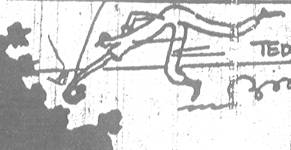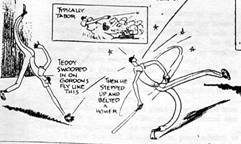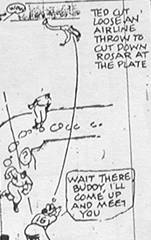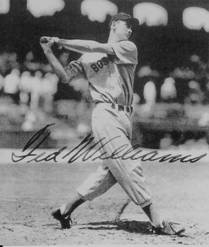
THE SPLENDID
SPRINTER
By John B
Holway
In all the talk about great moments in Yankee
Stadium history, has anyone mentioned great
catches? Two of the three best
I ever saw came there.
The first was by Joe Medwick of the Dodgers
in the first game of the 1941 World
Series. Joe DiMaggio pulled
one deep to left. Medwick drifted
to the low rail, braced his right hand on it, and hoisted himself up to snare
the home run away from Joe.
DiMaggio never hit a World Series homer in the Stadium, and the reasons
were two: Joe Medwick and Al
Gionfriddo in 1947.
I asked Medwick about to it in
John B Holway is author of
Ted,
the Kid, published by Scorpio books.
My second greatest catch was by Jimmy Piersall
in
The greatest catch of all was by Teddy Ball
Game in
deep toward the old bullpen in left-center,
between the grandstand and the bleachers, 405 feet
away.
Ted galloped in pursuit like a spastic Ichabod
Crane fleeing from the Headless Horseman, his elbows flailing and sleeves
flapping, on long, gangling legs like a day-old
colt. At the last second he
stretched out his long, skinny arm like an old-fashioned grocer plucking
a package off a high shelf with one of those extension
“grabbers.” The ball
smacked his mitt, and Ted smacked the fence at the same
instant. He folded himself over
the rail like a wet dish towel as we all held our breaths until he slowly
unwound.
And he had the ball in his hand.
James P Dawson of
the Times called it ”a
hair-raising, one-handed catch over the shoulder on the
run.” Roger Birtwell of
the
The
At bat Ted went 1-4 against Vic Raschi, who
had never lost a major league game in his life – he was
9-0. Second baseman Snuffy Stirnweiss played short rightfield
and threw Ted out on two hard line
shots. First baseman George
McQuinn, also in short right, snared another hard drive on the foul
line.
In the tenth, Ted caught Joe out of position
in rightfield and lined one to straight-away
center. By the time Joe turned around and ran it down, Ted had
slid in with a double. Bobby
Doerr, as usual, spanked a hit, and Ted chugged for
home. Joe uncorked what
A guy behind me gave a Bronx cheer and yelled that Ted took a wide
turn around third. (No papers
mentioned a wide turn.) In a
youthful excess of bad judgment, I turned and challenged him until my friends
pulled us apart, luckily for me – he'd have creamed
me.
The Sox won it in the
13th. But the papers
next morning all told about Ted getting thrown out and put it in graph
two. His catch was in graph 12 of
the Times, in graph 14 of the
Globe.
Back then there was no TV of course, and no
daily highlights or play of the day on
ESPN. We all relied on what
we read in the paper. No wonder Ted wore – and still wears – a bum
rap as a poor fielder.

 However,
the Globe’s sports cartoonist,
Gene Mack, often
However,
the Globe’s sports cartoonist,
Gene Mack, often
pictured great plays by Ted in the Fenway
outfield, such as these from the ’41 and ’47
seasons. (Mack didn't
travel to road games, so he didn't see the Yankee Stadium
catch.)
A month later, in the 1947 World Series,
Gionfriddo made a catch almost identical to Ted’s Stadium
grab. All the papers in the country ran a picture of it, and
millions saw it on
TV.
But there were no pictures to immortalize
Ted’s catch. If you weren't
there in person and didn't read beyond the first 11 graphs of the news stories,
you never knew it happened.
 Ten
years later, when he should have been
DH-ing, Williams had to walk
to pick up any ball that fell ten feet away from
him. So those who saw him then
reinforced the stereotype that he couldn't
field.
Ten
years later, when he should have been
DH-ing, Williams had to walk
to pick up any ball that fell ten feet away from
him. So those who saw him then
reinforced the stereotype that he couldn't
field.
No wonder nobody knows that in his youth he
was an above-average fielder with a good
arm.
Only Carl Yastrzmeski played the Fenway Wall
as well as Ted, who often held batters to a
single.
Ted played with three great centerfielders
– Piersall, Dom DiMaggio, and Doc
Cramer. He gladly yielded room
to them: “You take it,
Dommie!” But
Dom insisted that Ted was a
good fielder: “We never bumped into each
other.” And Doerr said
that when Williams challenged him to a race, “By golly, you had to go
all out to keep up with him.”
If Ted had been a small man, like Pete Rose, they'd have called it
“hustling.” But for
a big guy it looked like loafing.
There was a third reason DiMaggio never hit
a World Series homer in the Stadium -- the diabolical architect who designed
the House Built for Ruth. Yes,
and maybe a fourth reason – Joe’s stubborness in pulling long outs
into the Valley instead of poppng easy shots into the Porch.
That gave Gionfriddo and Williams the chance
to make some fielding gems.

338 pages, softcover
$40 + $4 s&h
Scorpio Books
 “If you think
you've read everything about Ted, think
again. I knew him for
65 years since we were friends
in high school, and I've never read any book like this
one. Holway has new facts and statistics and pictures on almost
every page. He spent hours talking
to Ted and found out things Ted never told anyone
else. Most people don’t
know that he was half-Mexican or how his uncles taught him to play, and even
I didn't know that he called his shots on at least 17 home
runs. There’s a lot of
new stuff on his battles with the writers, his famous All Star Game home
run, Joe DiMaggio’s streak, and about Cobb, Sisler, Hornsby, and other
.400 hitters. This book really
brings the man and that era to life.
It’s a box seat ticket to
history.”
Bob Breithart, director, San Diego Hall of
Champions.
“If you think
you've read everything about Ted, think
again. I knew him for
65 years since we were friends
in high school, and I've never read any book like this
one. Holway has new facts and statistics and pictures on almost
every page. He spent hours talking
to Ted and found out things Ted never told anyone
else. Most people don’t
know that he was half-Mexican or how his uncles taught him to play, and even
I didn't know that he called his shots on at least 17 home
runs. There’s a lot of
new stuff on his battles with the writers, his famous All Star Game home
run, Joe DiMaggio’s streak, and about Cobb, Sisler, Hornsby, and other
.400 hitters. This book really
brings the man and that era to life.
It’s a box seat ticket to
history.”
Bob Breithart, director, San Diego Hall of
Champions.
“Well done. There
were plenty of people who racked Ted up and wanted to bring out the bad in
the guy. He had a lot of pressure
on him, but he was a really compassionate
guy. Holway has told it like
it is.”
Bobby Doerr,
Hall of Fame, Red Sox 1938-50.
“The ballplayers all loved
Ted. He was a great hitter,
a great human being, and a great friend.
Holway’s book captures the spirit of those years –
absolutely. Reading it is like
being there in person. Every
serious baseball fan should have it in his library or on his coffee
table.”
Bob Feller, Hall of Fame, Indians,
1936-56.
About The
Last 400 Hitter
 “Holway’s accounting of the miraculous 1941 season
is a joy to read. Thoroughly
researched and carefully detailed, it is an affectionate tribute to a ballplayer,
a season, and an era.”
“Holway’s accounting of the miraculous 1941 season
is a joy to read. Thoroughly
researched and carefully detailed, it is an affectionate tribute to a ballplayer,
a season, and an era.”
“I entered baseball at just about the same time Ted
did, so it was great fun reading about Ted’s life, and it brought back
many memories. John B Holway
has skillfully revived a remarkable period in baseball history, as well as
the turbulent world surrounding it.
I thoroughly enjoyed reliving those times through this delightful
book.”
Jean Yawkey, former Red Sox
chairman of the board.
“Holway is the John Wayne of the
keyboards.”
John Thorn,
editor, “Total
Baseball.”